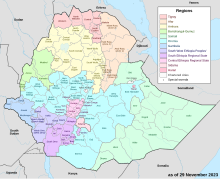TheOromia Zone(Oromo:Godina Oromiyaa;Amharic:ኦሮሚያ ዞን) is a zone inAmhara RegionofEthiopia.Oromia is named for theOromo people,who settled along the edge of theEthiopian Highlandsthat form this Zone. Oromia Zone is bordered on the southwest byNorth Shewa Zone,on the northwest bySouth WolloandArgobba special woreda,and on the east by theAfar Region.The Zone consists of 7 Woredas which are Artuma Fursi, Bati, Bati Town, Dewa Cheffa, Dewa Harewa, Jilye Tumuga and Kemisie town.Kemiseis the administrative center of the Zone.

The Oromia Zone was created in the late summer of 1994, according to one account in response to pressure from theOromo Liberation Front,which was actively agitating for autonomy forWollo Oromoduring late 1991 and early 1992.[1]Fourworedaswere taken from Debub Wollo—Baati, Dewe, Esseya Gulla and Artuma—and two woredas from Semien Shewa—Fursi and Senbete—and appointing Kamisee to be the Zonal capital. The new zone was organized into five woredas by combining Artuma and Fursi into one and renaming Esseya Gola to Chaffa Gola.[2]The numbers and areas of the constituent Districts have since changed.
Demographics
editBased on the 2007 Census conducted by theCentral Statistical Agencyof Ethiopia (CSA), this Zone has a total population of 457,278, a decrease of -1.23% from the 1994 census, of whom 227,328 are men and 229,950 women; with an area of 3,470.04 square kilometers, Oromia has a population density of 131.78. While 51,728 or 11.31% are urban inhabitants, a further 2,005 or 0.44% are pastoralists. A total of 101,442 households were counted in this Zone, which results in an average of 4.51 persons to a household, and 97,957 housing units. The two largest ethnic groups reported in Oromia were theOromo(86.07%), and theAmhara(12.54%); all other ethnic groups made up 1.39% of the population.Oromowas spoken as a first language by 82.13%, and 16.99% spokeSomali;the remaining 0.88% spoke all other primary languages reported. 97.07% wereMuslim,and 2.4% of the population said they practicedEthiopian Orthodox Christianity.[3]
The 1994 national census reported a total population for this Zone of 462,951 in 97,025 households, of whom 232,461 were men and 230,490 women; 39,666 or 8.57% of its population were urban dwellers at the time. The three largest ethnic groups reported in Oromia were theOromo(65.34%), theAmhara(31.79%), and theArgobba(2.29%); all other ethnic groups made up 0.58% of the population.Oromowas spoken as a first language by 65.08%, and 34.29% spokeAmharic;the remaining 0.63% spoke all other primary languages reported. 98.01% wereMuslim,and 1.92% of the population said they practicedEthiopian Orthodox Christianity.[4]
According to a May 24, 2004World Bankmemorandum, 5% of the inhabitants of Oromia have access to electricity, this zone has a road density of 23.9 kilometers per 1000 square kilometers (compared to the national average of 30 kilometers),[5]the average rural household has 0.6 hectare of land (compared to the national average of 1.01 hectare of land and an average of 0.75 for the Amhara Region)[6]and the equivalent of 0.5 heads of livestock. 10.9% of the population is in non-farm related jobs, compared to the national average of 25% and a regional average of 21%. 25% of all eligible children are enrolled in primary school, and 3% in secondary schools. 100% of the zone is exposed tomalaria,and none toTsetse fly.The memorandum gave this zone a drought risk rating of 565.[7]
2021 Clashes in Oromia Zone
editNotes
edit- ^Sarah Vaughan,"Ethnicity and Power in Ethiopia"ArchivedAugust 13, 2011, at theWayback Machine(University of Edinburgh: Ph.D. Thesis, 2003), p. 240 n. 259
- ^"Field Trip to North Shewa, Oromo and South Welo Zones of Region 3 (Amhara) 31 August - 3 September 1994"UNDP Emergencies Unit for Ethiopia report, dated September 1994 (accessed 13 January 2009)
- ^Census 2007 Tables: Amhara RegionArchivedNovember 14, 2010, at theWayback Machine,Tables 2.1, 2.4, 2.5, 3.1, 3.2 and 3.4.
- ^1994 Population and Housing Census of Ethiopia: Results for Amhara Region,Vol. 1, part 1ArchivedNovember 15, 2010, at theWayback Machine,Tables 2.1, 2.11, 2.14, 2.17 (accessed 6 April 2009)
- ^"Ethiopia - Second Road Sector Development Program Project",p.3 (World Bank Project Appraisal Document, published 19 May 2003)
- ^Comparative national and regional figures comes from the World Bank publication,Klaus Deininger et al. "Tenure Security and Land Related Investment", WP-2991Archived2007-03-10 at theWayback Machine(accessed 23 March 2006).
- ^World Bank,Four Ethiopias: A Regional Characterization(accessed 23 March 2006)